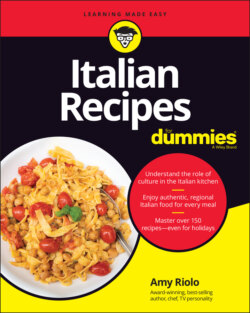Читать книгу Italian Recipes For Dummies - Amy Riolo - Страница 34
How foreign powers influenced cuisine across geographic locations
ОглавлениеAs foreign rulers came into power in different places in Italy, they often left their imprint on regional cuisine and took local traditions back to their countries of origin. It’s important to realize that some cities in Italy are closer to France or North Africa than they are to Rome — and each region’s cuisine reflects this. Sometimes, tourists to Italy eat only in establishments that offer what we consider to be “Italian food,” and at first glance they have a hard time distinguishing what is local and what is regional. Scratch a bit below the surface, however, and you will find many unique foods in each Italian region. Here are just a very few of them:
Austrian influences in the Northeast: In the areas around Venice, in the Veneto and places like Udine, as well as in Trentino Alto Adige where it is estimated that 40 percent of the inhabitants speak German as a first language, you will find local versions of pretzels, sauerkraut, rye bread, goulash, and Austrian-inspired pastries such as Viennoiseries.
Provencal synergy in Genoa and Liguria: The shared history between Southern France and the Italian Riviera has given way to many similar recipes – from focaccia (fougasse) to pesto (pistou) and the abundant use of chickpea flour.
Greek and Arab influences in Sicily and port cities: Two waves of Arab occupation — the Aghlabids and the Fatimids — beginning in the ninth and tenth centuries in Sicily introduced mulberries, gelato, lemons, oranges, eggplants, couscous, marzipan, and many other ingredients to the largest island in the Mediterranean. Because Venice, Istanbul (then Constantinople), and Cairo were once sister cities in the spice trade, Venice (along with other port cities such as Genoa) received a great deal of revenue from spices, and they became important in the foods of those regions. Saffron, nutmeg, cinnamon, cloves, and ginger were just a few. Eventually, the spices became synonymous with luxury and holiday dishes, and the ingredients were introduced to the rest of the country.
French influences in Piedmont: French was the official language of the court until the mid-19th century, and French influences can still be noticed today. Due to the similar terrain, corn, barley, wheat, rye, and oats are grown along with grape orchards, fruit trees, and vegetables. Home to 70 percent of Italy’s rice production, along with trout and frogs from the mountain rivers and the presence of the white truffle, French cuisine lends itself to the region.
Spanish Rule: From the 16th to the 18th century, many Italian states (everyone except Venice) were ruled directly by Aragon, as is evidenced by the many Aragonite castles that dot the Southern Italian coastline. During this time, it was Spanish, not Italian, interests which were protected in Italy. Many people believe that many modern Italian disparities are rooted in the type of absentee governing and land ownership that began during this time period. The prevalence of tomatoes, chocolate, peppers, corn, and other ingredients brought in by the Spanish from the New World to Europe are culinary staples that were introduced during these times.
The Kingdom of the Two Sicilies: From 1816 to 1860, from Naples down to Sicily, there was a Kingdom whose rule passed back and forth between the French and Spanish. The Italian south (especially its agriculture) was exploited by foreign influences until the 19th century. Nowadays the culinary influence can be seen very much in the patisserie of the area. Rum baba and brioche are both Neapolitan and French specialties. In Sicily, many Chefs still go by the name Monzu, which is a Sicilianized version of the word monsieur, because it was en vogue to have a French chef in Sicily during that period.
It is important to note that the examples above are just a few of the countless ways in which Italy’s cuisine was and still is influenced by foreign powers. Throughout the recipe chapters of this book, you also learn a few of the ways in which recipes from Italian regions, such as those of the Florentine courts, inspired other cuisines, such as the Grande Cuisine of Paris, and many others. One of the most beautiful aspects of gastronomy is that the food we eat is always changing, evolving, and adapting to our tastes and needs. The more we know about the history of various cuisines, the better equipped we are to create delicious food and to pass it down to future generations with the power to promote culture and fuel economies.
